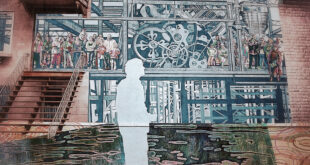"Just because the microphone in front of you amplifies your voice around the world, is no reason to think we have any more wisdom than we had when our voices could reach only from one end of the bar to the other."
Edward R. Murrow
Indian entertainment, primarily recognized as a producer of films, has jumped into TV with the same passion for the entertainment of the masses, offering constant commentary from "talking heads" on new TV channels and increasing satellite transmission till it has permeated the country. There may not be running water in some villages, but cable TV appears an essential commodity. Often, TV personalities have achieved the same level of deification as movie stars. The town hall discussion format has taken a grip on channels. In this context, the war is bringing out a diversity of opinion, and, in a country of an estimated one billion people, television, rather than the print media, is the bridge to understanding the war.
Bringing the war into Indian homes presents its own unique dilemma. India is in an ambivalent position in its Iraq war coverage, perhaps due to regional interests and past experience. Parts of India, such as the south and especially Kerala, a huge part of whose labor force lives in the Gulf region including Iraq, are much affected by what happens in the Middle East. During Desert Storm, India took the unpopular position of supporting Saddam Hussein, invoking Kuwait's ire and resulting in the expulsion of the many Indian citizens living there while India retained Iraq's friendship and continuous working relationship. Ensuing years have brought closer ties with the USA and Israel and thus some shift in vision. More than in other countries, therefore, the announcement of the contracting of American companies to rebuild Iraq inflamed Indian commentators, since this was one of the carrots dangled in front of India by the US in return for its support. The huge Indian work force assumed they would be involved in the reconstruction of post-war Iraq due to its proximity and experience.
Overall, India has taken a position of nebulous support for Western efforts while denouncing the war and this has affected the way the conflict is portrayed, especially on Indian government-run Prasar Bharti channel Doordarshan (DD). CNN became a fully integrated part of the Indian home during India's early satellite telecasts of Iraq's invasion of Kuwait in 1991. This influenced Indian news to modernize its facilities and CNN has in fact lent its expertise to train DD's News arm, including its international satellite news channel. As in most countries, however, viewers prefer privately-run channels like Star, Aaj Tak, and Zee for their news reports because of the greater freedom and reduced censorship.
India has a special relationship with the BBC, dating back to the time of British rule, when BBC radio news provided a window to the world for most Indians. Indeed, in India good English was called "BBC English." Yet this time around, the BBC in India does not seem as "plucky" in its coverage as in past wars, a difference that may be attributed to Britain's role as an integral partner in the war and the consequent constraints. BBC Asia takes the region into consideration but the Indians seem to prefer to watch war coverage from an Indian point of view.
As satellite television increasingly telecasts transnationally to India, the Iraq conflict is bringing into Indian homes the continuous live coverage of international channels such as CNN, BBC, WNBC, Dubai TV, German, Italian, and French TV, and Fox News (seen partly through Star News in India) as part of the cable network. Yet a preponderance of viewers prefer the comfort of regional channels in local languages like Hindi (in the north), Telegu (Andhra Pradesh), Malyalam (Kerala), and Tamil (Tamil Nadu), which also telecast to the Gulf region, where a majority of the labor force from these states works.
Indian satellite television news coverage cannot compete with more established channels covering the war that have correspondents embedded with military units in the field. What they can do is to offer their own perspective and more local coverage of local reactions, including that of the large Muslim population. An executive of one Indian TV company said to a reporter from Indiantelevision.com, "War is a serious issue, but it has its novelty value for TV channels and audiences too, what with the latest gizmos and weaponry on display and being utilized."
Since the onset of the war coincided with the Cricket World Cup, in which India was a finalist, the early fighting could not lure viewers away from the game, which is a national passion. Satellite television vied for these same audiences, especially with advertisements committing themselves to an Indian war coverage. The TV reality show of war quickly became a fix on the news but did not displace American channels, with Bollywood film channels offering the anecdote for war watching in India.
Doordarshan as a terrestrial TV still counts for an estimated 70 percent of viewers in India that do not have satellite television and with government funding, has assigned the war coverage to a private company, Saeed Naqvi's Third Eye. This well-regarded journalist has always paid attention to the Muslim and Hindu perspectives in his work and is known for resourceful investigative reporting. DD Director General S.Y. Quraishi said that the channel opted for a private company rather than expensive insurance for their correspondents to cover the war.
Third Eye produces a daily half-hour show for DD, with one of the teams in Kuwait, with additional feeds sent through satellite that can be used for its various news bulletins and translated for its DD regional channel. Some of the reporting has been faulted, with DD and Third Eye sometimes not "seeing eye to eye." One reported discrepancy, according to IndianTelevision.com, occurred when Sasi Kumar for Third Eye reported Indians in Kuwait deciding to stay in Kuwait along with their Kuwaiti friends, while a DD news team broadcast images immediately afterwards of Indians returning by the planeload from the Gulf.
Some viewers in India have always preferred the more feisty news channel, Aaj Tak (translated as "Today There") of TV Today Network, which has sometimes reported controversial stories. Reportedly, the channel has linked an exclusive deal with another hard-hitting channel, Al Jazeera, for footage of the Gulf War. Aaj Tak has sent three teams to countries around Iraq including anchor Deepak Chaurasia in Kuwait, as well as tying up with local TV stations there and international agencies like APTN and Reuters for footage. Interspersed with war coverage are discussion panels and groups, a technique of which Indian viewers are fond.
"Broadcast journalism around the world is at cross-roads but the integrity of the profession has never been in more danger than we find it," said CNN president Chris Cramer in a video-linked speech on 15 March at the FICCI FRAMES 2003 conference in Mumbai.
Indian war coverage also seems to be at a transnational cross-road of maturity in terms of bringing its own identity and professionalism into broadcasting to one of the world's largest populations.
 Arab Media & Society The Arab Media Hub
Arab Media & Society The Arab Media Hub




